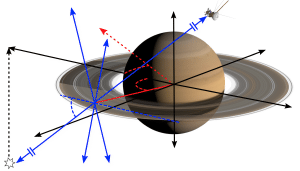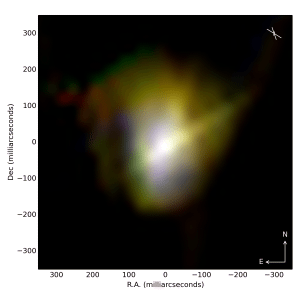Blog
Ringer
3 March 2015
 Stewart, et al
Stewart, et alOne of the things astronomers are good at is gathering data in unexpected ways. In astronomy you can’t just go to what you want to study, nor can you do all of your experiments in the lab. Gathering useful data can be difficult, so when you get an event like the transit of Venus or the fortune of Jupiter having four large moons, you take advantage of it. For example, new work being published in MNRAS proposes a way to use the Cassini spacecraft and the rings of Saturn to resolve stars.1
 Stewart, et al
Stewart, et alAs Cassini orbits Saturn, it’s view of background stars are often occulted by the rings of Saturn. By observing a star as the rings pass in front of it, we can gather information about the star. Occultations have long been part of the astronomer’s toolbox, such as using the Moon’s occultation of distant stars to discover binary stars, or the occultations by asteroids to determine their shape. The power of this type of approach is that since an occultation gradually blocks and unblocks the distant object, we can gather data about the object “a slice at a time.”
In this paper, the authors demonstrate how this data can be used to reconstruct an image of the star, which provides data on its size and brightness profiles. They then used occultation data gathered by Cassini to produce an image of a couple stars, such as Mira. The resolution of the images produced varies a bit depending on the occultation, but it is roughly on the order of milliarcseconds, which is pretty impressive. What makes it more impressive is that Cassini was never specifically designed for this kind of thing.
It just goes to show what ingenuity and a wealth of freely accessible data can get you.
Stewart, Paul N., et al. “High angular resolution stellar imaging with occultations from the Cassini spacecraft–II. Kronocyclic tomography.” Monthly Notices of the Royal Astronomical Society 449.2 (2015): 1760-1766. ↩︎